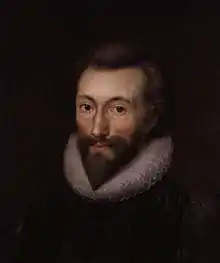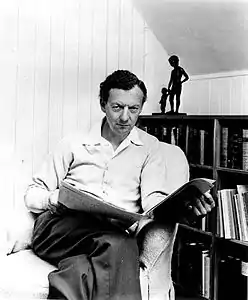Holy Sonnets
Die Holy Sonnets (Heilige Sonette) – auch bekannt als Divine Meditations (Göttliche Meditationen) oder Divine Sonnets (Göttliche Sonette) – sind ein Zyklus von neunzehn geistlichen Gedichten des englischen Dichters John Donne (1572–1631).

Der Zyklus
Der Zyklus von Sonetten wurde erstmals 1633 veröffentlicht (unvollständig), zwei Jahre nach dem Tod von John Donne, überwiegend in der Art der von dem italienischen Renaissance-Dichter Francesco Petrarca (1304–1374) vorgeschriebenen Form, in dessen Liebeslyrik das Sonett aus zwei Quartetten (vierzeiligen Strophen) und einer sechszeiligen Strophe besteht, mit dem Reimschema abba - abba - cde - cde (u. a.). Verschiedene Muster in Rhythmus und Struktur sowie die Einbeziehung von Paaren sind jedoch Elemente, die von dem englischen Dichter William Shakespeare (1564–1616) entwickelte Sonett-Form beeinflusst worden sind (siehe auch Shakespeares Sonette).
Das Werk John Donnes macht ihn sowohl in seiner Liebeslyrik als auch in der religiösen Dichtung zu einer der zentralen Figuren unter den metaphysischen Dichtern. Häufig werden darin Vergleiche zwischen irdischer und göttlicher Liebe gezogen.
Die neunzehn Gedichte der Sammlung wurden zu Donnes Lebzeiten nie veröffentlicht, obwohl sie in Manuskripten verbreitet waren. Viele der Gedichte sollen 1609 und 1610 in einer Zeit großer persönlicher Not für Donne geschrieben worden sein, der in dieser Zeit physische, emotionale und finanziellen Probleme hatte. Dies war auch eine Zeit persönlicher religiöser Turbulenzen, als Donne sich im Prozess der Bekehrung vom römischen Katholizismus zum Anglikanismus befand und trotz großer Zurückhaltung und erheblicher Selbstzweifel 1615 zum Priester ordiniert wurde.[1]
Es wird angenommen, dass das Sonett XVII ("Since she whom I loved hath paid her last debt" / "Seit jene, die ich liebte, ihre letzte Schuld bezahlt hat") 1617 nach dem Tod der Ehefrau von Donne, Anne Moore, geschrieben wurde.[1]
In den Heiligen Sonetten befasst sich Donne mit den religiösen Themen der Sterblichkeit, des göttlichen Gerichts, der göttlichen Liebe und der demütigen Buße, während er über persönliche Ängste nachdenkt.[2]
Das Westmoreland-Manuskript (Westmoreland manuscript) von 1620 liefert die vollständigste Version dieser Sonette.[3]
Titel der einzelnen Sonette

- Thou hast made me, and shall thy work decay
- As due by many titles I resign
- O might those sighs and tears return again
- O my black soul! now thou art summoned
- I am a little world made cunningly
- This is my play's last scene, here heavens appoint
- At the round earth's imagined corners, blow
- If faithful souls be alike glorified
- If poisonous minerals, and if that tree
- Death be not proud, though some have called thee
- Spit in my face you Jews, and pierce my side
- Why are we by all creatures waited on?
- What if this present were the world's last night?
- Batter my heart, three-personed God; for you
- Wilt thou love God, as he thee! then digest
- Father, part of his double interest
- Since she whom I loved hath paid her last debt
- Show me, dear Christ, thy spouse so bright and clear
- O, to vex me, contraries meet in one
Sonett XIV und der Trinity-Test
Der Deckname für den Trinity-Test – d. h. der Ausdruck „Trinity“ (deutsch „Dreifaltigkeit“) – wurde Robert Oppenheimer, dem „Vater der Atombombe“, zufolge gewählt, weil er bei der Namensgebung an ein Gedicht von John Donne gedacht habe, worin es heiße: „Zerschlage mein Herz, dreifaltiger Gott“[4][5] (im Original der Dichtung: „Batter my heart, three-person'd God“). Eine weitere Erklärung dafür habe er nicht.[6][7][8]
Vertonungen

Neun der Sonette wurden von dem Komponisten Benjamin Britten (1913–1976) in einem Liederzyklus[9] vertont (The Holy Sonnets of John Donne, op. 35).[10] Einige der Sonette wurden auch von John Tavener (1944–2013) vertont, auch von John Eaton.
Literatur
- Colin Burrow (Hrsg.): Metaphysical Poetry. Penguin, London 2006, ISBN 0-14-042444-X.
- Don M. Ricks: The Westmoreland Manuscript and the Order of Donne's "Holy Sonnets", Studies in Philology, Vol. 63, No. 2 (Apr., 1966), pp. 187–195 (Online-Teilansicht)
Siehe auch
- Death be not proud[11] (englisch)
Einzelnachweise und Fußnoten
- Smith, A.J. Biography: John Donne (Poetry Foundation). Abgerufen am 26. November 2017.
- Frederick J. Ruf: Entangled Voices: Genre and the Religious Construction of the Self. 1997, S. 41 (Online-Teilansicht)
- Zum Westmoreland Manuscript vgl. digitalcollections.nypl.org: The Westmoreland manuscript of the poems of John Donne & digitaldonne.tamu.edu: Bibliographical Description of the Westmoreland Manuscript of Donne's Poems
- „Batter my heart, three-person’d God“ - abgerufen am 26. November 2017.
- John Donne HOLY SONNETS XIV. „Batter my heart, three-person'd God; for you As yet but knock ; breathe, shine, and seek to mend ; That I may rise, and stand, o'erthrow me, and bend Your force, to break, blow, burn, and make me new. I, like an usurp'd town, to another due, Labour to admit you, but O, to no end. Reason, your viceroy in me, me should defend, But is captived, and proves weak or untrue. Yet dearly I love you, and would be loved fain, But am betroth'd unto your enemy ; Divorce me, untie, or break that knot again, Take me to you, imprison me, for I, Except you enthrall me, never shall be free, Nor ever chaste, except you ravish me.“Donne, John. Poems of John Donne. vol I. E. K. Chambers, ed. London: Lawrence & Bullen, 1896. S. 165 (Digitalisat)
- „I did suggest it, but not on that ground… Why I chose the name is not clear, but I know what thoughts were in my mind. There is a poem of John Donne, written just before his death, which I know and love. From it a quotation: 'As West and East / In all flatt Maps—and I am one—are on, / So death doth touch the Resurrection.'“ („Hymn to God My God, in My Sicknesses“). Oppenheimer continued, „That still does not make a Trinity, but in another, better known devotional poem Donne opens, 'Batter my heart, three person'd God;—.' Beyond this, I have no clues whatever.“ (Holy Sonnets XIV). (Richard Rhodes: The Making of the Atomic Bomb. New York: Simon & Schuster, 1986, S. 571–572 (Online-Teilansicht)).
- Countdown to the Eve of Destruction, von ANTHONY TOMMASINI; New York Times, 3. Oktober 2005 „(…) the first bomb was tested at the site that Oppenheimer, inspired by a John Donne poem, called Trinity. (…)“ - abgerufen am 26. November 2017.
- Los Alamos National Laboratory – Trinity: Completion of the Wartime Mission „Los Alamos Director J. Robert Oppenheimer named the site "Trinity" after a poem by John Donne that he had been reading.“ - abgerufen am 26. November 2017.
- Klangbeispiel (Peter Pears, Tenor; Benjamin Britten, Klavier)
- vgl. lieder.net: The Holy Sonnets of John Donne:
- IV: "Oh my blacke Soule! now thou art summoned"
- XIV: "Batter my heart, three person'd God"
- III: "Oh might those sighes and teares return againe"
- XIX: "Oh, to vex me, contraryes meet in one"
- XIII: "What if this present were the world's last night?"
- XVII: "Since she whom I lov'd hath pay'd her last debt"
- VII: "At the round earth's imagined corners"
- I: "Thou hast made me, and shall thy work decay?"
- X: "Death be not proud"
- vgl. gedichte.xbib.de: Sonett über den Tod (Bertram Kottmann)
Weblinks
- librivox book
- Metaphysical Poets (englisch)
- Die erste Atombombe ließ die Messgeräte schmelzen (Johann Althaus)